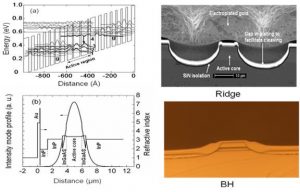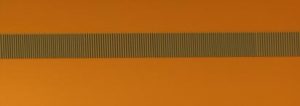Mid-infrared lasers: quantum cascade lasers
Quantum cascade lasers (QCLs) are semiconductor lasers that emit in the mid-infrared to THz regions of the electromagnetic spectrum. QCLs are unipolar devices based on intersubband transitions. QCLs play important roles in various applications such as standoff chemical detection, photoacoustic sensing, environmental monitoring, medical diagnosis, etc.

QCL energy band structures, mode profile, BH waveguide, ridge waveguide.


Atomic layers inside a QCL that consists of hundreds of layers. Each layer thickness is a few nm.
(1) Integrated tunable DBR QCL



Tunable DBR QCL with two sections. Grating and gain sections; assembly of DBR QCL; wavelength tuning; cross-section of BH structure.
Ref:
Liwei Cheng, Dingkai Guo, Xing Chen, Douglas Janssen and Fow-Sen Choa, “Integrated tunable DBR QCLs”, SPIE Photonic West, paper 7616-44, San Francisco, CA, Jan. 23-28, 2010.
(2) Super-structure grating

A super structure grating with variable grating periods
(3) Thermal simulation of QCLs



Thermal analysis of QCL with ridge, BH structures, and BH structure with epi-down bonding
(4) High power QCL array




(5) Surface emitting QCL array


Comparison of edge emitting and surface emitting. Surface emitting QCL array with 5 emitters, both laser facets HR coated.
Ref:
Xing Chen, Liwei Cheng, Dingkai Guo, Fow-Sen Choa, “Heat dissipation consideration of high-power mid-infrared quantum cascade laser arrays,” in CLEO: Science and Innovations, OSA Technical Digest (online) (Optical Society of America, 2012), paper CTh3N.7.
Xing Chen, Liwei Cheng, Dingkai Guo, Fow-Sen Choa, Jiun-Yun Li, John Bruno, John Bradshaw, Kevin Lascola, Richard Leavitt, John Pham, Fred Towner, “Surface emitting quantum cascade laser arrays” Frontiers in Optics, paper FTh4D.8, Oct. 14-18, 2012